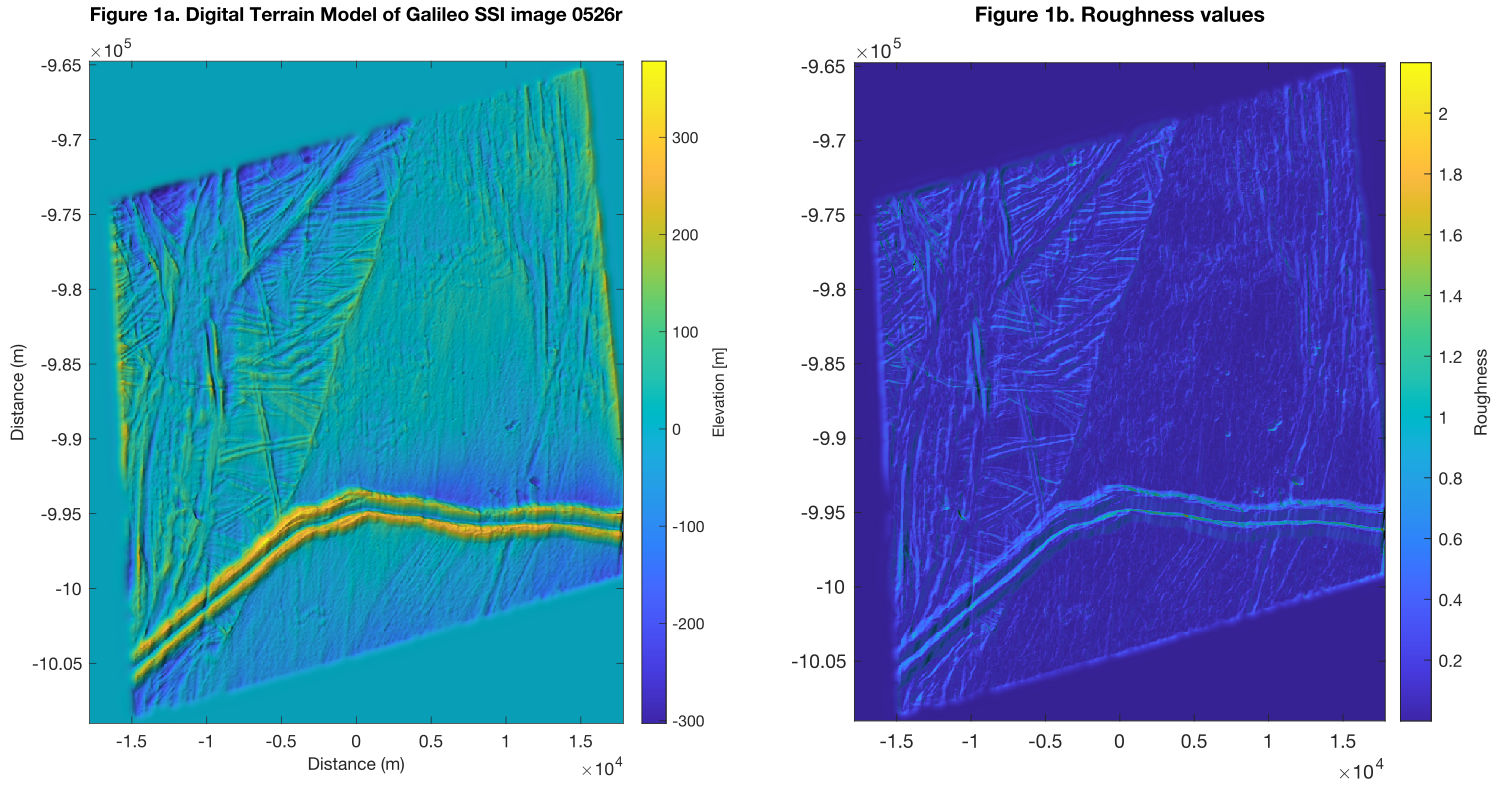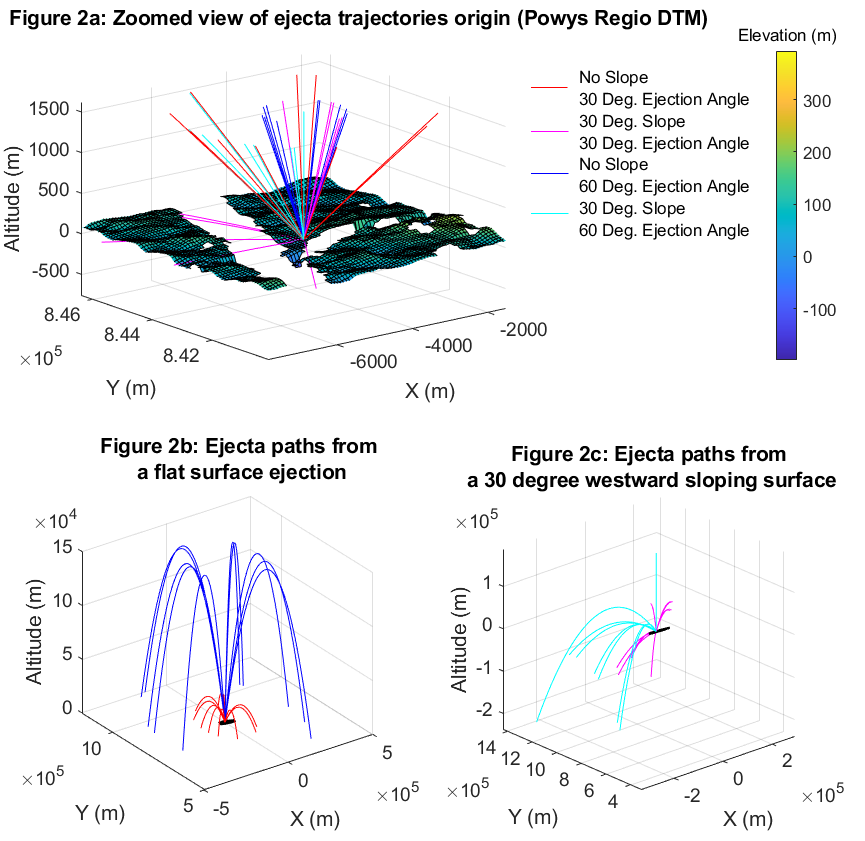Surface and topographic characteristics of geological features on Europa and their effects on ejecta particle dynamics
- Freie Universität Berlin, Institute of Geological Sciences, Planetary Sciences and Remote Sensing, Germany (pietro.matteoni@fu-berlin.de)
Events which emplace fresh material onto Europa’s surface may be irregular and catastrophic, such as large-scale impacts or localized, and potentially extant, processes in which faults, fractures, or brine transport bring subsurface liquid onto the surface. This liquid may originate from shallow reservoirs within the ice shell or directly from the ocean [1].
Emplacement may be a slow, extrusive process, or quicker, potentially with the formation of cryovolcanic plumes (e.g. [2,3,4]). Plume deposits or any other surface material can also be transported to high altitudes by another mechanism: when hypervelocity interplanetary micrometeoroids, or larger objects, impact the surface of an atmosphereless planetary body like Europa, these can generate impact ejecta with high enough velocities to reach altitudes of hundreds of kilometres [5]. Most of these ejecta particles are gravitationally bound, moving on ballistic trajectories lasting up to hundreds of seconds and producing an almost isotropic dust exosphere around Europa [6,7]. Subsurface oceans, in the Jovian and in other planetary systems, can therefore be characterized using the particles they emit, via either indirect or direct routes: 1) Detection and analysis of ejecta particles lofted by micrometeoritic impacts from those parts of the surface that recently interacted with subsurface waters (e.g certain landforms, such as chaos terrains on Europa, or plume deposits); 2) Direct sampling of plume particles in space (where plumes are present, as perhaps possible on Europa).
The time-of-flight mass spectrometer SUrface Dust Analyzer (SUDA), onboard the Europa Clipper spacecraft, is designed to measure the compositions and trajectories of such impact ejecta particles and/or plume material [8]. SUDA is an impact ionisation time-of-flight mass spectrometer, which uses the ions generated by hypervelocity impacts of dust grains onto the instrument target to generate mass spectra of the impinging particles. Depending on the altitude SUDA will be able to detect up to tens of ejected surface particles per second during each flyby, each likely to contain a wide variety of organic and/or inorganic compounds, and via trajectory reconstruction, map them to their origins on the surface [8].
The trajectories of impact ejecta, and potentially even those of directly emitted plume grains, are likely to be considerably affected by local surface properties, over a range of scales. Here we present our initial progress in producing new, and collating existing (e.g [9]), digital terrain models (DTMs) of the Europan surface, together with the development of Monte Carlo impact ejecta trajectory simulations which consider variations in ejecta mass and velocity distributions.
DTMs have been produced using both stereophotogrammetry and photoclinometry techniques, through the Integrated Software for Imagers and Spectrometers (ISIS) and the Ames Stereo Pipeline (ASP) Shape-from-Shading (SfS) tool [10], based on Galileo’s Solid-State Imager (SSI) images. In the case of Fig. 1a, through SfS we obtain a DTM of image 0526r with a resolution of ~35 m/px, following the methodology described in [11]. One of the most important parameters that can be calculated from DTMs is surface roughness (Fig. 1b), a measure that describes the height distribution of asperities. Its variations affect the trajectories and yield of ejecta particles generated by micrometeoroid impacts, along with the angles at which plume particles might be emitted. The DTMs of features of interest, with their associated roughness and slope information, will provide an important input for ejecta trajectory simulations.

Previous models [6,8] have assumed particles originate from perfect planar surfaces, whereas actual micrometeoroids impact surfaces with varying characteristics, such as roughness and slope, over a range of incidence angles. These initial properties result in variations in excavated ejecta mass, ejection angles, and ejecta speeds that, if accounted for, will increase the ability of SUDA to map accurately Europa’s surface. Utilizing DTM-derived surface information, and realistic assumptions of surface properties at smaller scales, an impact ejecta simulation code, derived from the parameters and equations of [6] and more recent works [12,13], is under development. Ejecta trajectories and velocities are produced for typical impactors (i.e. an impactor of mass 1 x 10-8 kg, striking at 9 km s-1), accounting for external influences such as gravitational focusing and Coriolis deflection. The output of this code is shown in Fig. 2, which shows the trajectories of multiple ejecta originating from a location within Powys Regio. In one version of this figure (Fig. 2b), we assumed the surface the ejecta originates from is flat or has a slope of 0 degrees; in 2c we assume the surface has a westward decline at 30 degrees. The surface slope changes the potential maximum altitude an ejecta particle can reach, which adds constraints to the path-retracing process compared to assuming a flat surface. Surface roughness is still being implemented and was not considered in producing Figure 2. After adding roughness to the model, we intend to use this code to perform a Monte Carlo-type simulation, similar to Fig. 2, to determine the effect surface characteristics have on interpreting trajectory paths from a simulated flyby of Europa Clipper.

1. Head, J.W., & Pappalardo, R.T., (1999). J. Geophys. Res. 104, 27143–27155.
2. Roth, L., et al., (2014). Science 343, 171.
3. Sparks, W.B., et al., (2017). The Astrophysical Journal Letters, 839(2), L18.
4. Jia, X., et al., (2018). Nat. Astron. 2, 459.
5. Koschny, D., & Grün, E., (2001). Icarus, 154(2), 402-411.
6. Krivov, A. V., et al., (2003a). Planetary and Space Science 51, 251-269.
7. Postberg, F., et al., (2011). Planetary and Space Science, 59(14), 1815–1825.
8. Kempf, S., et al., (2014). LPI Contributions 1774, 4052.
9. Giese, B. et al., (2020). Mendeley Data, V1
10. Alexandrov, O., & Beyer, R. A., (2018). Earth and Space Science, 5, 652–666.
11. Lesage, E., et al., (2021). Icarus, Volume 361, 114373
12. Szalay, J.R., et al., (2018). Space Sci Rev, 214:98.
13. Goode, W., Kempf, S., Schmidt, J., (2021). preprint version, submitted for publication.
How to cite: Matteoni, P., Hayes, T., Hillier, J., and Postberg, F.: Surface and topographic characteristics of geological features on Europa and their effects on ejecta particle dynamics, Europlanet Science Congress 2021, online, 13–24 Sep 2021, EPSC2021-244, https://doi.org/10.5194/epsc2021-244, 2021.

